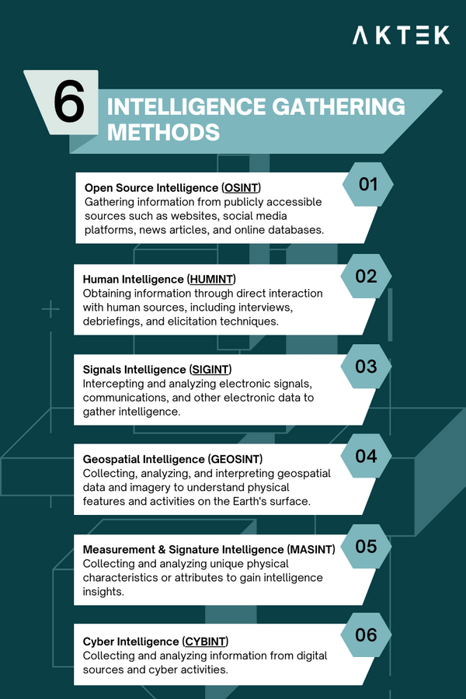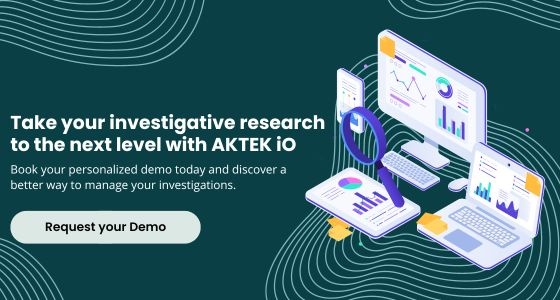In the ever-changing landscape of today's world, intelligence gathering has emerged as a cornerstone for making informed decisions and gaining a competitive edge.
Collecting and analyzing pertinent information from diverse sources has become a critical skill for governments, organizations, and businesses alike.
However, with the vast amount of data available, it is essential to follow best practices to ensure the accuracy, relevance, and ethical conduct of intelligence collection.
In this blog, we delve into the science of intelligence gathering, exploring the most effective practices that empower analysts to transform raw data into actionable insights.
From identifying reliable sources to employing cutting-edge technologies, join us on a journey to unlock the secrets of successful intelligence gathering.
The Intelligence Cycle
.jpg?width=708&height=398&name=Blog%20Link%20Preview%20Image%20(35).jpg) The intelligence cycle is a systematic process that intelligence agencies and organizations follow to gather, analyze, and disseminate intelligence information.
The intelligence cycle is a systematic process that intelligence agencies and organizations follow to gather, analyze, and disseminate intelligence information.
It consists of several interconnected stages that form a continuous loop, enabling the gathering and utilization of intelligence for decision-making and action.
The collection step in the intelligence cycle is a foundational phase where raw data is gathered from various sources to provide a basis for further analysis and intelligence production.
It is a critical stage that sets the groundwork for the entire intelligence process. During this phase, intelligence professionals employ various methods and techniques to acquire information relevant to the organization's intelligence requirements.
Once information is collected, it undergoes further processing, analysis, and dissemination to transform raw data into valuable intelligence that informs decision-making and action.
The success of the entire intelligence cycle relies on the quality, comprehensiveness, and accuracy of the data collected during this crucial phase.
Key Aspects of Intelligence Gathering
Let's explore the key considerations of the collection stage in the intelligence cycle:
Intelligence Requirements
The collection step is guided by intelligence requirements, which are specific information needs identified during the planning and direction phase of the intelligence cycle.
These requirements outline what information is necessary to support decision-making and address key strategic questions.
Identification of Sources
The first step in the collection phase involves identifying potential sources of information.
Identify relevant sources and establish search parameters that align with your goals.
These sources can be broadly categorized as open sources (publicly available information), closed sources (classified or restricted access information), human sources (informants or agents with access to specific knowledge), and technical sources (e.g., signals intelligence, geospatial data, cyber data).
Employ advanced search techniques, including Boolean operators, filters, and keyword optimization, to supercharge the efficiency and accuracy of your data collection.
Intelligence Gathering Methods
Intelligence professionals utilize a wide range of collection methods to gather information from identified sources.
These methods may include:- Open Source Intelligence (OSINT): Gathering information from publicly accessible sources such as websites, social media platforms, news articles, and online databases.
- Human Intelligence (HUMINT): Obtaining information through direct interaction with human sources, including interviews, debriefings, and elicitation techniques.
- Signals Intelligence (SIGINT): Intercepting and analyzing electronic signals, communications, and other electronic data to gather intelligence.
- Geospatial Intelligence (GEOSINT): Collecting, analyzing, and interpreting geospatial data and imagery to understand physical features and activities on the Earth's surface.
- Measurement and Signature Intelligence (MASINT): Collecting and analyzing unique physical characteristics or attributes to gain intelligence insights.
- Cyber Intelligence (CYBINT): Collecting and analyzing information from digital sources and cyber activities.
Embrace the most fitting collection methods based on your objectives and available sources.
This could include web scraping, data mining, social media monitoring, or manual searching.
Each method has distinct advantages and limitations, so you can carefully select each source to optimize your efforts.
Source Validation
Before incorporating collected information into intelligence analysis, its credibility and reliability must be assessed.
Intelligence professionals validate sources to ensure that the data is accurate, unbiased, and free from manipulation.
Cross-referencing multiple sources and triangulating information enhances confidence in the intelligence product.
Legal and Ethical Considerations
Intelligence collection must adhere to legal and ethical guidelines.
It is crucial to respect privacy rights, follow applicable laws, and ensure that the methods used do not compromise security or violate any regulations.
Timeliness
Timeliness is a key factor in intelligence collection, especially in rapidly changing environments or time-sensitive operations.
The ability to collect, process, and analyze information quickly enhances the relevance and effectiveness of intelligence products.
Data Handling and Storage
Collected data must be carefully managed and securely stored to prevent unauthorized access, data breaches, or loss.
Proper data handling ensures the confidentiality and integrity of sensitive information.
Security
Safeguard the integrity of your collected data through robust security measures.
Implement encryption, secure networks, and precise access controls to prevent unauthorized access, theft, or manipulation.
Adhere to relevant privacy regulations and guidelines to ensure compliance.
Prioritizing security builds trust and ensures the integrity of your intelligence operations.
Flexibility and Adaptability
Intelligence collection often requires flexibility and adaptability to adjust to dynamic situations, evolving intelligence requirements, and changing sources of information.
Storage
Avoid the pitfalls of neglecting storage considerations. Develop a secure and organized system to prevent issues.
Ensure your storage solution is reliable, scalable, and supports seamless data retrieval.
Regularly back up your data to safeguard against loss or corruption.
Processing
Establish well-defined guidelines and processes for collecting and transforming data.
Document each step, from source identification and verification to data capture and handling sensitive information.
This fosters consistency and transparency in your collection process, particularly as your team scales in the future.
Audit Trail
Maintain an intricate record of your entire data collection process, capturing sources consulted, search queries used, and timestamps for data retrieval.
This comprehensive audit trail ensures accountability and enables traceability in the case of discrepancies or disputes.
In the fast-paced digital landscape, where sources can vanish quickly, preserving records, including screenshots with metadata when feasible, mitigates the risk of losing critical information.
Source Quality
Uphold the highest standards by verifying the credibility and reliability of the sources from which you collect information.
Cross-reference multiple sources to validate data accuracy and minimize the risk of misinformation or bias.
A rigorous approach to source evaluation enhances the overall quality of your intelligence.
Data Quality
Elevate the bar of excellence by maintaining superior data quality throughout the collection process.
Prioritize double-checking the accuracy and relevance of collected information before incorporating it into your analysis or decision-making.
Leveraging data collection tools with mandatory fields or entries can enforce data excellence across your team.
Leveraging a Data Collection Tool
Embracing a powerful data collection tool becomes imperative to optimize and streamline the Intelligence collection process, propelling efforts to new heights and amplifying the impact of actionable insights.
Here are some compelling reasons why such a tool is indispensable in today's dynamic information landscape:
Process Efficiency
Manually collecting and sifting through information can be overwhelming and time-consuming in the vast ocean of publicly available data.
A robust data collection tool automates the process, effortlessly gathering data from diverse sources and organizing it into a centralized repository.
This automation drastically reduces manual effort, enabling analysts to focus on critical tasks such as data analysis and interpretation.
Comprehensive Coverage
Intelligence sources are vast and diverse, ranging from social media platforms and news websites to online databases and forums.
A data collection tool harnesses the power of technology to scour this expansive landscape comprehensively.
It ensures that valuable information is kept from the cracks, allowing for a comprehensive and holistic understanding of the subject.
Real-time Monitoring
In today's rapidly changing world, real-time intelligence is invaluable.
A data collection tool with real-time monitoring capabilities keeps a vigilant eye on the digital landscape, promptly capturing and analyzing emerging information.
This timeliness empowers organizations to respond swiftly to evolving situations, enabling proactive decision-making and crisis management.
Advanced Analytics
Beyond mere data collection, a powerful tool should have advanced analytics and visualization features.
These capabilities transform raw data into actionable intelligence, offering valuable insights through sentiment analysis, topic clustering, and trend identification.
The tool's analytical prowess aids in identifying patterns, correlations, and anomalies that might go unnoticed.
Enhanced Data Quality and Integrity
Data integrity is critical in intelligence operations.
Data collection tools offer mechanisms for data validation, ensuring that the information collected is accurate, reliable, and up-to-date.
By eliminating redundant or misleading data, these tools bolster the overall quality and credibility of the intelligence generated.
Customizable Workflows
Different intelligence projects may have unique requirements and objectives.
A versatile data collection tool allows analysts to tailor workflows to specific needs, accommodating diverse sources and data types.
This flexibility fosters adaptability, making the tool a powerful asset in addressing various intelligence challenges.
Secure Intelligence Management
The sensitive nature of intelligence data demands robust security measures.
Data collection tools offer secure storage solutions with encryption, access controls, and audit trails to protect against unauthorized access, data breaches, or tampering.
This fortification of data security ensures that intelligence operations remain confidential and compliant with data protection regulations.
Collaboration and Knowledge Sharing
In a collaborative intelligence environment, a data collection tool serves as a centralized platform where team members can share findings, insights, and analyses.
This synergy fosters collective intelligence and enables seamless collaboration, promoting a more comprehensive and cohesive understanding of complex issues.
Scalability and Consistency
As intelligence requirements grow, a data collection tool can scale effortlessly, accommodating increased data volumes and expanding teams.
The tool's systematic data collection and management approach ensures consistency across the intelligence process, regardless of the project's size or complexity.
Collecting Open Source Intelligence with AKTEK iO
AKTEK iO is a prime example of a tool that empowers you in multiple ways.
It offers a wide range of data collection methods, including structured reports, real-time social media monitoring, automated sentiment analysis, topic clustering, search engine results analysis, automatic screenshot acquisition, near real-time monitoring of natural hazards and geopolitical events, and analysis of anonymous mobility patterns, among other cutting-edge features.
AKTEK iO further supports bespoke business processes applied to acquired data, ensuring data quality and investigative integrity.
A detailed and immutable audit trail provides a transparent record of changes over time, bolstering credibility and traceability.
Moreover, AKTEK iO fosters centralized intelligence, effective access management, and seamless collaboration among team members, promoting synergy and driving shared analysis.
In Summary
Analysts can generate invaluable intelligence across various domains by adopting systematic data collection approaches, implementing robust storage strategies, verifying sources, ensuring data quality, and protecting collected data.
By embracing best practices and utilizing the right tools, organizations can fully harness the transformative power of information, enabling a comprehensive understanding and better-informed decisions grounded in accurate and reliable intelligence.


.jpg?width=300&name=Blog%20Link%20Preview%20Image%20(34).jpg)

